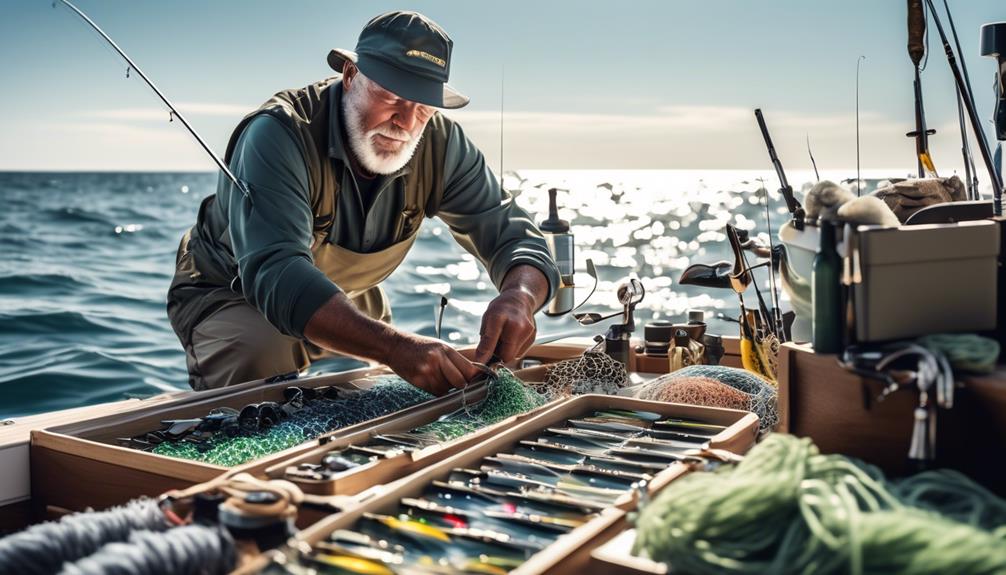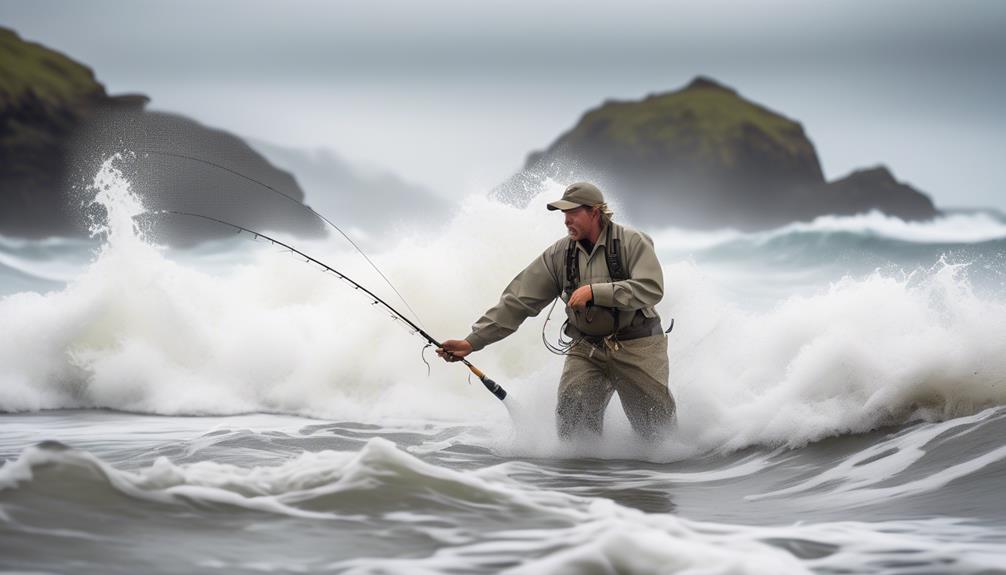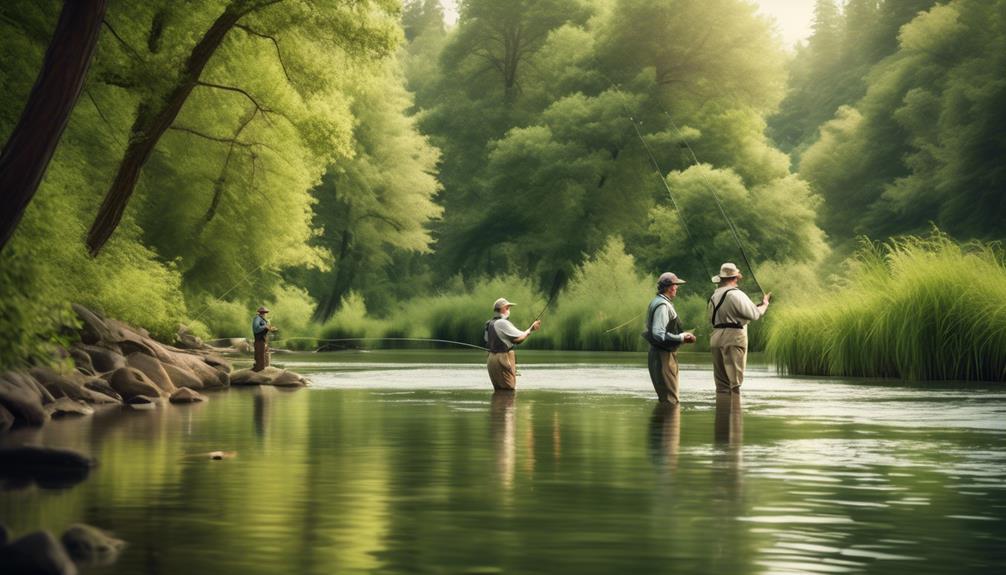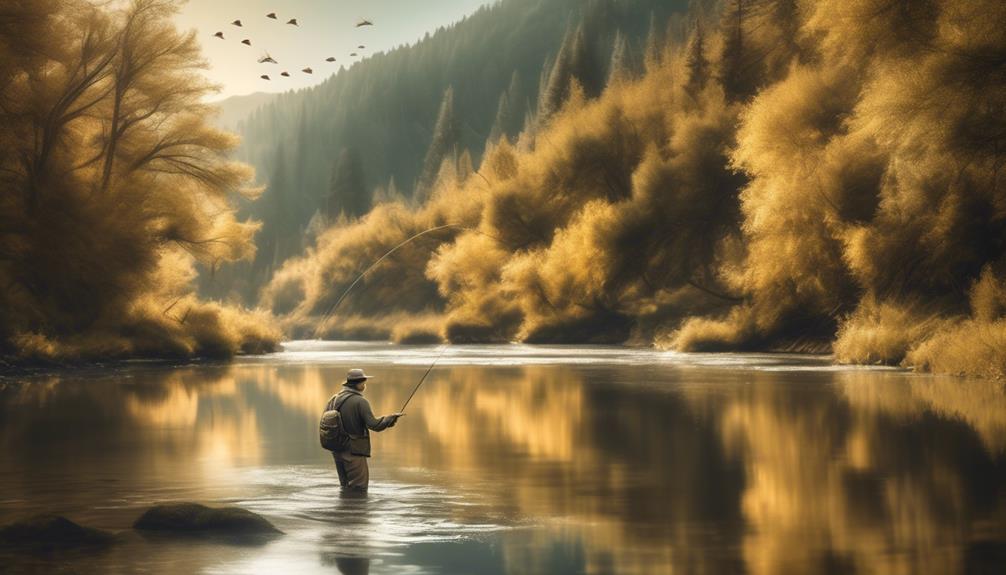You might think that fly fishing in saltwater is just like fly fishing in freshwater, but it's a whole different ballgame.
The challenges you face in saltwater are unique and require a different set of skills and strategies. From dealing with the elements to handling powerful fish, saltwater fly fishing presents a whole new set of obstacles.
But once you understand the intricacies of this environment, you'll find that the rewards are well worth the effort.
Understanding Saltwater Environment
To successfully fish in saltwater, you need to understand the unique environment and its effects on the behavior of the fish. Tidal movements play a crucial role in saltwater fishing. The rising and falling tides influence the behavior and feeding patterns of various species. During the incoming tide, baitfish and other prey are carried into the estuaries, attracting predatory fish. Understanding these tidal movements helps you anticipate where the fish will be and when they'll be feeding, increasing your chances of a successful catch.
Species behavior is another key aspect to comprehend. Different species of saltwater fish exhibit varied behaviors and preferences. For example, some fish are more active during certain times of the day, while others may prefer specific habitats such as shallow flats or deeper channels. Knowing the behavior of the target species allows you to tailor your approach for a more effective fishing experience.
When it comes to saltwater fly fishing, saltwater fly selection and presentation techniques are critical. The selection of the right fly pattern is essential for enticing the fish to strike. Factors such as size, color, and silhouette of the fly play a significant role in attracting the attention of saltwater species. Additionally, mastering presentation techniques, such as casting accurately in varying wind conditions and water depths, is crucial for enticing the fish to take the fly.
Understanding these elements of the saltwater environment is fundamental for a successful saltwater fly fishing experience. By considering tidal movements, species behavior, and mastering fly selection and presentation techniques, you can enhance your effectiveness in this challenging and rewarding fishing environment.
Matching the Hatch in Saltwater
When fly fishing in saltwater, it's essential to match the hatch by selecting fly patterns that mimic the natural prey available to the fish. Understanding the tides and timing is crucial when it comes to matching the hatch in saltwater. Saltwater fish often feed based on the movement of the tides, so knowing the tides and their impact on the location you're fishing is vital. Fish tend to be more active and feeding during certain tidal phases, such as incoming or outgoing tides, so timing your fishing expedition accordingly can significantly improve your chances of success.
Fly selection is another critical aspect of matching the hatch in saltwater. You need to carefully observe the behavior of the fish and the natural prey in the area to determine the most suitable fly patterns. Various factors, such as the size, color, and movement of the natural prey, should influence your choice of fly. For example, if you notice that the fish are targeting small shrimp, selecting a fly pattern that mimics the movement and appearance of shrimp can be highly effective. Additionally, considering the depth at which the fish are feeding and adjusting your fly pattern accordingly can make a substantial difference in your catch rate.
Dealing With Wind and Currents
Fishing in saltwater presents a challenge when dealing with strong winds and powerful currents. In windy conditions, casting techniques become crucial for successful saltwater fly fishing. To overcome the challenges posed by the wind, anglers often use the backhand cast or the Belgian cast, which can help in casting against the wind with better accuracy and distance. Additionally, adjusting the casting angle and using heavier flies can also aid in cutting through the wind more effectively.
Navigating strong currents requires strategic fishing approaches. When facing powerful currents, it's essential to identify areas where fish may seek refuge from the force of the water. Look for eddies, pockets of calm water, or areas with structure where fish are likely to hold. Using sinking lines or weighted flies can help get the fly down to the desired depth despite the current. Additionally, casting at an angle downstream and allowing the fly to swing across the current can mimic the natural movement of prey, making it more enticing to the fish.
When dealing with both windy conditions and strong currents simultaneously, it becomes even more challenging. In such situations, casting at an angle that takes advantage of the wind's direction and using mends to control the fly's drift become essential. Adjusting the casting angle and mending the line to counteract both wind and current forces is crucial for presenting the fly naturally to the fish. Developing the skills to adapt to these conditions will ultimately make you a more versatile and successful saltwater fly angler.
Selecting the Right Fly Patterns
Navigating strong currents requires strategic fishing approaches, and selecting the right fly patterns is essential for enticing fish in these challenging conditions. When it comes to saltwater fly presentation, the right fly pattern can make all the difference. Here are some tips to help you select the perfect fly patterns for saltwater fly fishing:
- Match the Hatch: Pay attention to the prevalent baitfish and crustaceans in the area. Matching the size, shape, and color of the natural prey can significantly increase your chances of success.
- Consider Water Clarity: In clear water, fish can scrutinize your fly more closely. Opt for natural, translucent patterns. In murkier water, brighter and more contrasting patterns can help grab the attention of fish.
- Vary Depth and Retrieve: Have a selection of fly patterns that fish at different depths and mimic various swimming behaviors. This versatility can help you adapt to changing conditions and the behavior of different species.
- Experiment and Observe: Don't be afraid to try different patterns and closely observe how fish respond. Sometimes, a slight change in pattern can trigger more strikes.
Mastering Long Distance Casting
To achieve mastery in long distance casting, focus on refining your technique and utilizing the power of your casting motion. When it comes to casting techniques, it's crucial to maintain a smooth, controlled motion throughout the entire cast. Start by mastering the basic overhead cast, then progress to the double haul and other advanced techniques. Proper timing and coordination between your casting hand and rod hand are essential for generating maximum line speed and distance accuracy.
Distance accuracy is the key to successful saltwater fly fishing. To achieve this, pay attention to your casting stroke. The power should come from a smooth acceleration, followed by an abrupt stop, allowing the rod to unload its energy efficiently. This creates tight loops, which are essential for casting long distances accurately. Additionally, focus on your body positioning and weight transfer. Your body should move in sync with your casting motion, adding extra power to your cast.
When mastering long distance casting, practice is essential. Spend time casting on the water, simulating the conditions you'll encounter when fishing. This will help you adapt your technique to different wind and water conditions, ultimately leading to improved distance and accuracy.
Handling Big and Strong Fish
After perfecting your long distance casting technique, you'll need to be prepared to handle big and strong fish when they strike. When facing these powerful adversaries, it's crucial to employ the right fighting techniques and use proper equipment to ensure a successful catch. Here's how you can effectively handle big and strong fish:
- Fighting Techniques: Once you feel the pull of a large fish, it's essential to maintain a steady but flexible posture. Keep the rod tip up to prevent the line from getting caught on underwater obstacles, and use smooth, steady pressure to tire out the fish without risking a snapped line. Additionally, learn to anticipate the movements of the fish and adjust your technique accordingly to maintain control during the fight.
- Proper Equipment: Having the right gear is crucial when it comes to handling big and strong fish. Ensure that your rod, reel, and line are suitable for the species you're targeting. A strong and reliable drag system on your reel is essential for controlling the fish and preventing it from making powerful runs that could lead to a lost catch.
- Managing Fatigue: Fighting a large fish can be physically demanding, so it's important to manage your energy effectively. Stay calm and focused, and use your body weight to your advantage when reeling in the fish. Additionally, practice proper breathing techniques to avoid exhaustion.
- Fish Behavior: Understanding the behavior of the species you're targeting can give you an edge. Different fish have varying fighting styles, and knowing how they typically react to being hooked can help you anticipate their movements and tire them out more efficiently.
Managing Saltwater Gear and Tackle

When handling your saltwater gear and tackle, it's essential to ensure that they're properly maintained and suited for the specific conditions of the environment. Saltwater fly fishing demands sturdy and durable gear due to the corrosive nature of saltwater. One crucial component of your gear is the saltwater fly line. It's designed to withstand the harsh saltwater environment and the powerful runs of saltwater species.
Regularly clean and treat your fly line to prevent it from becoming brittle and cracked, which can lead to breakage and lost fish. Additionally, ensure that your reels and rods are specifically designed for saltwater use, as they're built to resist corrosion and handle the heavier strains of saltwater fishing.
Another vital aspect to consider is tying saltwater flies. These flies need to be tied with materials that can withstand the corrosive effects of saltwater and the sharp teeth of predatory species. Using stainless steel or saltwater-grade hooks, and durable synthetic materials for the fly bodies and wings can help ensure that your flies hold up against saltwater conditions.
It's also important to rinse your flies in freshwater after each use to remove any salt residue that could cause deterioration.
Adapting to Changing Conditions
How do you adjust your saltwater fly fishing approach when faced with changing conditions?
Adapting to tides and navigating obstacles is crucial for success in saltwater fly fishing. Here are some key strategies to help you adapt to changing conditions:
- Understanding the Tides: Pay close attention to the tidal patterns in the area where you'll be fly fishing. Tides can significantly impact the behavior and location of saltwater game fish. As the tides shift, fish may move to different areas, so being aware of these changes is essential for adjusting your fishing approach accordingly.
- Flexible Fly Selection: Changing conditions often call for a change in fly patterns. Be prepared to switch out your flies based on the shifting environment. Keep a variety of fly patterns in your tackle box to adapt to the current conditions and the specific prey that the fish are targeting.
- Adapting Casting Techniques: Navigating obstacles such as changing winds or varying water depths requires adaptability in your casting techniques. Practice different casting styles to handle obstacles effectively. This flexibility will help you reach the fish in diverse conditions.
- Staying Alert and Observant: Remaining observant of the changing conditions is key. Keep an eye out for signs of fish activity and adjust your approach accordingly. Being alert to the shifting environment will help you make quick and effective decisions while fly fishing in saltwater.
Frequently Asked Questions
What Are Some Common Mistakes Beginners Make When Saltwater Fly Fishing?
When saltwater fly fishing, beginners often make mistakes like improper footwork, neglecting line management, and incorrect rod positioning. Make sure to focus on these key areas and remember to use the strip set technique.
How Can I Improve My Accuracy When Casting in Windy Conditions?
In windy conditions, improve casting accuracy by adjusting your fly fishing techniques. Use shorter casts, lower your casting angle, and choose heavier flies to combat wind resistance. Practice and adapt to different wind speeds for better accuracy.
What Are Some Safety Tips for Saltwater Fly Fishing in Rough Waters?
When fishing in rough waters, prioritize safety. Always wear proper safety equipment and know emergency procedures for rough water. Stay vigilant and prepared to handle any unexpected situations that may arise while saltwater fly fishing.
How Do I Properly Maintain My Saltwater Fly Fishing Gear?
To properly maintain your saltwater fly fishing gear, follow these cleaning tips. After use, rinse your gear with freshwater, let it dry, and store it properly. This will ensure the proper cleaning and maintenance of your tackle.
What Are Some Effective Strategies for Targeting Specific Saltwater Fish Species With Fly Fishing Techniques?
When targeting specific saltwater fish species with fly fishing techniques, it's crucial to focus on fly selection, location scouting, understanding tides, and mastering retrieval techniques. These strategies will help you improve your chances of a successful catch.
Conclusion
So, next time you're out on the saltwater, remember the unique challenges that come with saltwater fly fishing.
From understanding the environment to dealing with wind and currents, it's no easy feat.
But with the right skills and preparation, you can conquer these challenges and enjoy the thrill of catching big, strong fish in this dynamic and ever-changing environment.
Keep practicing, stay adaptable, and never stop learning from every experience.
Good luck out there!



